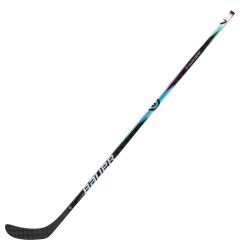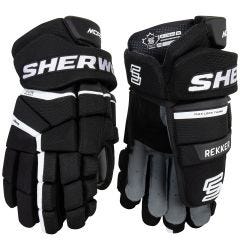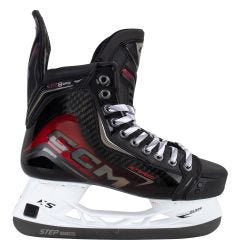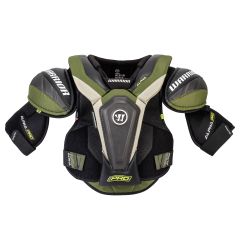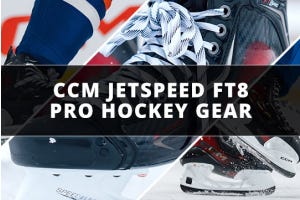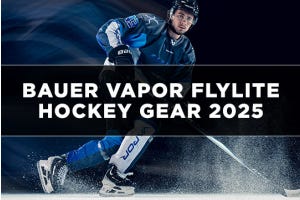Ice Hockey Positions: Skills, Roles & Responsibilities Explained
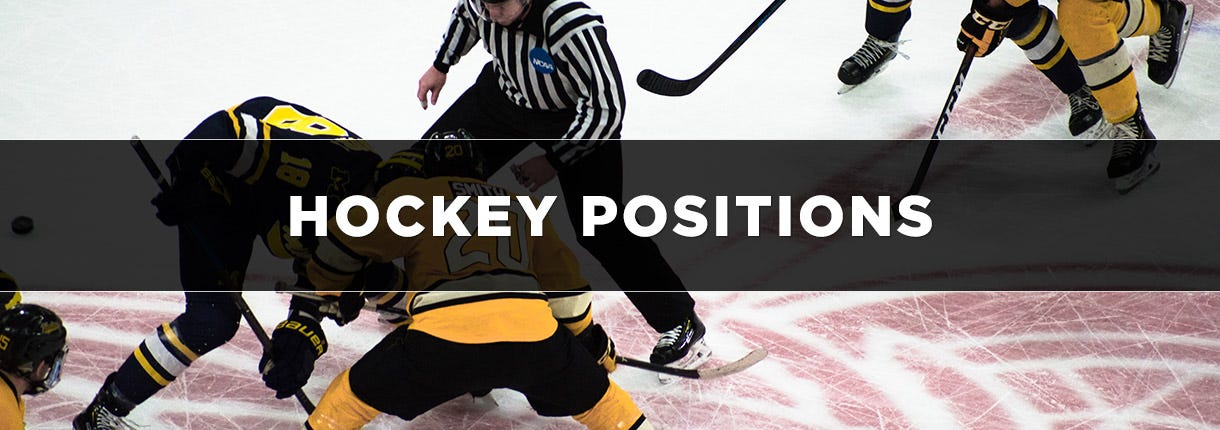
Upon watching a game of Ice Hockey, one may think it looks as if there is not a lot of structure or positioning from player to player. In fact, every player on the ice, for both teams, will have a different position and set of skills. Throughout this article you can learn further about what these positions are, their main responsibilities, and their individual skill sets. Additionally, player types will also be discussed along with some frequently asked questions. No matter what position you play, shop our full inventory of hockey equipment to get ready for your next game today!
Diagram of Hockey Positions
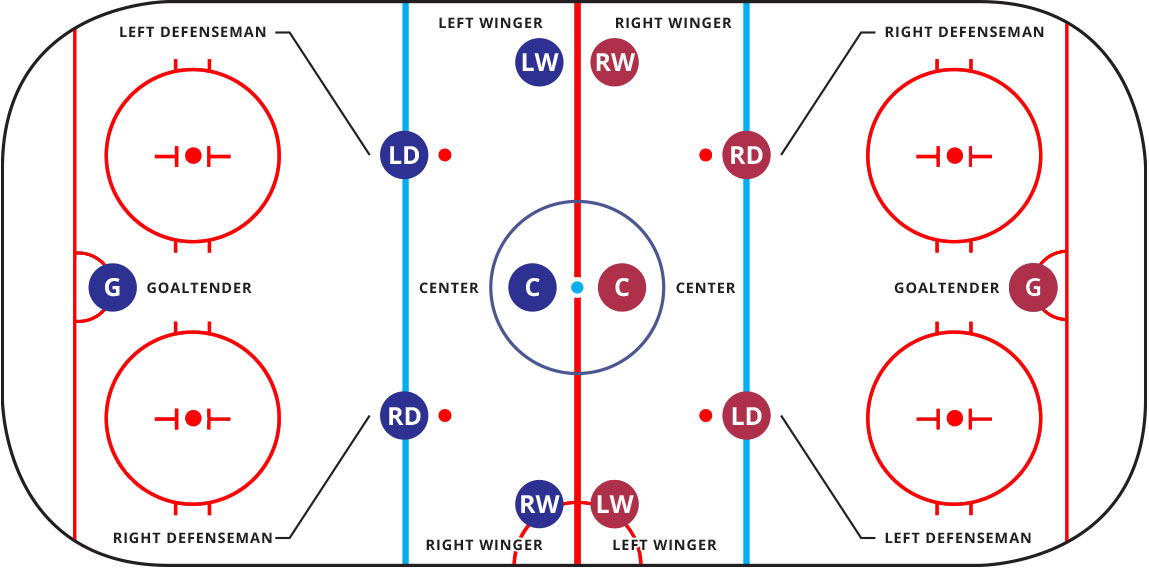

Hockey Forwards
The main objective for a forward in Ice Hockey, simply put, is to score on the opposing team’s goaltender. Generally speaking, forwards are shorter than defensemen and are usually quicker and shiftier on their skates, in order to get past the defensemen on the opposing team. Each team will have three forwards on the ice for a majority of the game, each one with specific roles and positioning on the ice. Below, we’ll look at just that; each position, their role, and their individual skills.
Center
The Center in Ice Hockey is generally the main player responsible for dictating the gameplay while the puck is in the offensive zone. They could also often be the ones responsible for skating the puck into the offensive zone as well.
Center Skills
While every player has a certain skill set, Centers are looked at as the “quarterbacks” of Ice Hockey. This means that their overall hockey sense and vision is always some of the best on the team, allowing them to find open space and teammates, and read plays before they happen. In addition, Centers typically have some of the best stick handling skills in tight areas, as well as great passing skills, making them valuable playmakers in the offensive zone.
Center Responsibilities
Centers have a variety of different responsibilities while on the ice, on both offense and defense. One of the primary responsibilities as a Center is to win faceoffs. This is crucial in order for their team to gain possession of the puck. Another key responsibility is to provide support for their wingers, meaning setting up the plays in the offensive zone, make great passes, and lead the forecheck and backcheck.
Center Positioning
While the puck is in the offensive zone, Centers will be found dictating the play from the middle of the zone. This zone includes in front of the opposing goalie, to the edge of each faceoff dot, and out to the blue line. From here, they can receive passes from teammates, dish passes to open wingers or defensemen, or simply screen the opposing goaltender for a potential goal. In the defensive zone, Centers have the most surface area to cover, spanning from the front of their net, up to the blue line, and out to each faceoff dot. Their job here is to lock down the slot area of their defensive zone. They should also be aware of where their other teammates are on the ice, to ensure that there are no open areas for the opposing team.
Left Wing
The Left Wing in Ice Hockey lines up to the left side of the Center and plays most of the game on the left side of the ice, on both offense and defense. These players range in sizes, but are usually bigger than Centers, but smaller than Defensemen.
Left Wing Skills
These offensive-minded players are looked at as the primary goal scorers, meaning the Left Wing will have a great wrist shot and slap shot. The Left Wing will also be required to be strong on the puck, in order to not get it stolen from opposing defensemen. Going hand-in-hand, Left Wingers will want to be strong against the boards while battle opposing players for the puck. Lastly, they must possess great ice vision to find open teammates on the ice.
Left Wing Responsibilities
Primary responsibilities of a Left Winger include getting good shots onto the opposing team’s net, make good passes to your Center in the slot, and battle for pucks in the corners and along the boards. Left Wingers can also often be the ones responsible for carrying the puck into the offensive zone and setting up the play for their team. Defensively, Left Wingers are responsible for locking down the opposing team’s right defenseman or intercepting passes between the two. If the puck is stolen by someone from their team, it is their responsibility to get open down the ice for a breakout pass.
Left Wing Positioning
While in the offensive zone, Left Wingers will play on the left side of the ice, ranging from the center of the left faceoff circle, to the left corner, to directly in front of the opposing goaltender. On defense, Left Wingers will stay high and defend the opposing team’s right defenseman. This zone will include up to the blue line and across to its halfway point, down to the halfway point of the left circle.
Right Wing
The Right Winger plays opposite of the Left Winger and to the right side of the Centerman. Like the Left Winger, the Right Winger will be responsible for locking down the right side of the ice, on both offense and defense.
Right Wing Skills
The Right Winger are looked at as the primary goal scorers on an Ice Hockey team. They will spend a majority, if not all, of the game roaming around on the right side of the ice, trying to get shots off on net. These players tend to have one of the best shots on the team, allowing them to snipe corners with ease! Right Wingers are also strong on their feet and strong with the puck on their stick. This allows them to win battles for the puck along the boards and to get away from opposing defensemen.
Right Wing Responsibilities
Like the Left Winger, Right Wingers are responsible for getting good shots onto the opposing team’s net, will frequently be the ones skating the puck into the offensive zone and setting up the play, be tasked to battle for the puck with opposing players when it goes to the boards or corners, and set up teammates with good passes for a potential scoring play. On defense, Right Wingers will be responsible for backchecking hard if the other team gains possession of the puck and cover open passing lanes in order to force a turnover.
Right Wing Positioning
On offense, Right Wingers will play on the right side of the zone. This includes the right corner, up to the right faceoff dot, and right in front of the opposing goalie.
Hockey Defensemen
During regular play, there will be two defensemen on the ice per team. The primary objective for defensemen in Ice Hockey is to stop the opposing team from scoring.
Left Defenseman
Working in unison with his defensive partner, the Left Defenseman will possess a variety of skills and responsibilities, on both offense and defense.
Left Defenseman Skills
Highly Skilled Left Defensemen are great skaters, especially backwards. They will also have great hockey IQ in order to read plays from the opposing team and determine where the puck and net is at all times, they have great shots, and are great passers, especially when making breakout passes from the defensive zone.
Left Defenseman Responsibilities
Left Defensemen are responsible for ensuring that the opposing team does not score. This includes blocking shots, finding open lanes and covering them, and battling with opposing wingers in the corners to get the puck. Additionally, Left Defensemen are responsible for controlling the play while in the defensive zone, meaning playing positionally sound so the opposing team does not get a good shot off on net.
Left Defenseman Positioning
While in their defensive zone, Left Defensemen are required to lock down the left corner of the ice. This includes the left corner, up to the center of the left faceoff dot, to in front of their net. In the offensive zone, Left Defensemen will stay on the top left side of the zone, which includes at the blue line, to center ice, to the top of the left faceoff dot.
Right Defenseman
Working in unison with his defensive partner, the Right Defenseman will possess a variety of skills and responsibilities, on both offense and defense.
Right Defenseman Skills
Right Defensemen will be some of the most skilled skaters on the team, especially backwards. They will also possess great hockey IQ helping them read plays and cover the open spots on the ice. They also have great shots, especially slap shots, and will be great passers, especially when making breakout passes from their defensive zone.
Right Defenseman Responsibilities
The primary responsibility for a Right Defenseman is to prevent the other team from scoring. This includes blocking shots, finding and covering open areas in the zone, and keeping heads on a swivel to make sure that they are always between the puck and their net. Additionally, Right Defensemen are responsible for controlling the play while in the defensive zone, meaning playing positionally sound to ensure that the opposing team does not get a good shot off on their net.
Right Defenseman Positioning
While in their defensive zone, Right Defensemen are required to lock down the right corner of the ice. This includes the right corner, up to the center of the right faceoff dot, to in front of their net. In the offensive zone, Right Defensemen will stay on the top right side of the zone, which includes at the blue line, to center ice, to the top of the right faceoff dot.
Hockey Goalie
The Goalie is the main player on the ice who is responsible for stopping pucks from entering the goal, when shot from the opposing team. Also, the goaltender has the most creative liberties when it comes to gear colors and their overall look on the ice.
Hockey Goalie Skills
In addition to making saves, ice hockey goalies possess many skills which include skating, rebound control, ability to fill space, cut down the angle to the shooter, stopping dump-ins, making breakout passes and helping direct teammates see the play behind them as a visionary on the ice.
Hockey Goalie Styles
The goalie position has developed over the last century. Starting with playing a pure stand up style and evolving into a hybrid style and ultimately ending in today’s butterfly style. Stand up goalies never went down to their knees and often made saves while standing up with their stick blade flat on the ice. Hybrid goaltenders started to drop down because of the realization that they can control rebounds better. However, they still had older tendencies to try and keep the upper body straight and often utilized a butterfly save with only one knee down at a time. The butterfly style has morphed and tweaked in the last three decades, however it is the most common style used by goaltenders as it provides the best probability of stopping the puck.
Butterfly
There are two types of butterfly goalies:
- - Hybrid Butterfly: Goalies who mix modern and older techniques to do what is necessary to stop the puck.
- - Athletic Butterfly: Goalies that rely on responsive, fast and often explosive movements to stop the puck.
Blocking Style
The most common style is the blocking butterfly which goalies drop down to reduce the open area for the puck to make it past them. Often these goalies drop, squeeze the body together and try to redirect pucks to the corner when making saves.
Hockey Player Roles
While the game of ice hockey consists of six different positions, each position has a “sub-category”, meaning the style of player playing that position will have a different role based on their skillset, physical stature, the line they play on, and so on.
Sniper
Snipers are generally the stars of their team and be looked upon to score a goal in a time of need. Having the best shot on their respective teams, they are expected to produce high goal scoring numbers year in and year out. Big name snipers currently in the NHL include Alex Ovechkin, Patrik Laine, and Nikita Kucherov.
Playmaker
While playmakers don’t always have the best shot, they make up for it with their great hockey IQ and creative passing abilities, as well as their superior ability to find open space on the ice. With pass-first mindsets, playmakers accumulate most of their points setting up their teammates for goals. Big name Playmakers currently in the NHL include Sidney Crosby, Connor McDavid, and Nathan MacKinnon.
Power Forward
Featuring a unique blend of strength, skill, and finesse, Power Forwards are essential for any hockey team. Usually bigger in stature compared to Playmakers or Snipers, Power Forwards are more so inclined to battle with opposing players during puck battles along the boards. If they get the puck in open ice, they also have enough skill to snipe a top corner with ease. Big name Power Forwards currently in the NHL include Jamie Benn, Blake Wheeler, and Aleksander Barkov.
Two-Way Forward
Two-Way Forwards usually do not excel in one specific category, but rather, possess the ability to complete any task that is thrown at them, on offense or defense. This includes assisting defensemen, making plays in the offensive zone, and taking faceoffs. Big name Two-Way Forwards currently in the NHL include Jonathan Toews, Patrice Bergeron, and Anze Kopitar.
Grinder
Grinders are players that are utilized for killing penalties, blocking shots, and their smart play in the defensive zone. The players are usually the biggest forwards on the team and are not afraid to throw their weight around. Getting into fights is also common for a Grinder. Big name Grinders currently in the NHL include Tom Wilson and Zach Hyman.
Enforcer
Enforcers are usually the scrappiest, most aggressive, and biggest players on the team. Their primary goal is to agitate opposing team’s stars and rough up opposing players. Their role also includes standing up for their teammates, which frequently means fist fights. Big name Enforcers currently in the NHL include Patrick Maroon, Milan Lucic, and Wayne Simmonds.
Offensive Defenseman
Adding to a team’s offense, Offensive Defensemen are great shooters possessing the ability to snipe goaltenders. They also have great stickhandling abilities allowing them to find open space on the ice. Offensive Defensemen are often great skaters as well, both fast and strong on their skates. Big name Offensive Defensemen currently in the NHL include, Erik Karlsson, PK Subban, and Brent Burns.
Shutdown Defenseman
As the name states, Shutdown Defensemen’s primary goal is to disrupt the opposing team’s goal scorers and players. While these players are not point scorers, they are vital assets to a team for their unmatched defensive abilities. Big name Shutdown Defensemen currently in the NHL include Mark Giordano, Alex Pietrangelo, and Jared Spurgeon.
Common Questions About Hockey Positions
How many players are on an ice hockey team?
NHL teams are allowed 23 players total on their rosters with most teams averaging 20 players suited per game. This consists of 12 forwards, 6 defensemen, and 2 goalies.
What is the most important position in hockey?
While some teams are offensively focused and others are defensively focused, there is not one single “most important” position. Forwards are important because they are the ones mainly tasked with scoring goals to put their team ahead, defensemen are important because they prevent the other team from scoring goals, and goalies are important because they are the ones stopping the opposing team from scoring goals.
What is the most difficult position to play in hockey?
It is said that goalie is the most difficult position to play within Ice Hockey, and one of the hardest to play in any sport. The main objective for a goalie is to keep the puck out of the net, and with a great one, they can control the game and greatly influence their team’s confidence.
Which hockey position scores the most goals?
This almost always depends on the team, but generally speaking, the Left Winger and Right Winger are looked as the primary goal scorers of most teams. Guys like Alex Ovechkin and Patrick Kane are two prolific veteran Wingers that have been firing pucks into the back of nets for more than a decade.
Which hockey position gets the most assists?
Centers are seen at the primary playmakers of almost every team; therefore, they will get the most assists, which usually means the most points. They are the players who “quarterback” plays while in the offensive zone and hit open players with great passes. Guys like Connor McDavid and Sidney Crosby are two highly intelligent and crafty players who use their hockey IQ’s to rack up points.
Which position should I play in hockey?
While there are many different factors when determining what position, you should play, this article will serve as a starting point when learning about each position. If you are a bigger player and strong on your skates, defense might be a good start. If you are a smaller, but quicker skater, and have good stickhandling skills, Winger might be a viable option.
Are NHL hockey positions the same as other leagues?
Yes, all positions in Ice Hockey, regardless of league, are the same. Two Wingers, one Center, two Defensemen, and one Goalie.




